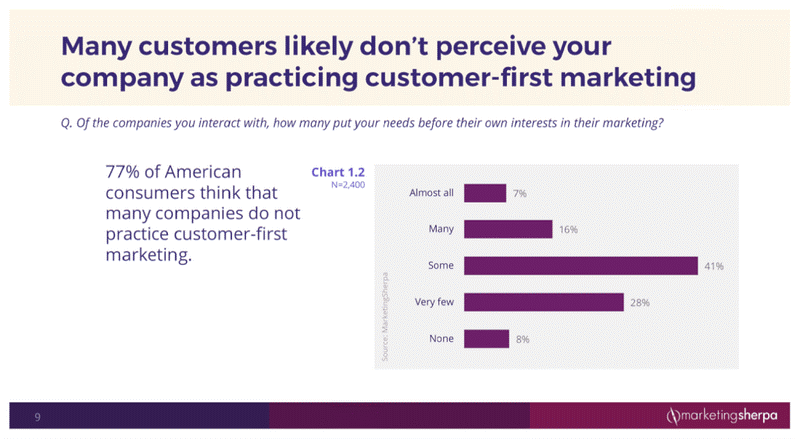
I know. It’s not a common question. And, what does it mean anyway? Does it mean being customer-oriented, customer-focused, and having a customer-centric mindset with the people your business or organization serves?
According to the new MarketingSherpa Customer Satisfaction Research Study, there’s a new term on the marketing scene called, “customer-first marketing” and it’s supposedly different from “customer-centric marketing.”
“Customer-centric marketing puts the customers at the center of marketing; all promotions and messaging flow towards them in the way that is most relevant to them. Marketers put themselves in the customers’ shoes to sell to them better.”
Customer-centric marketing typically consists of:
- Personalization
- Customization
- Assessing customer needs
- Maximizing efficiency
- Understanding needs and wants of customers
- Co-production and self service
“Customer-first marketing uses the customers’ goals as the compass to make decisions about marketing approach. They put the long-term interest of the customer above the short-term company conversion goals. Marketers put themselves in the customers’ shoes to serve them better, thus building a long-term, sustainable competitive advantage.”
In this approach, “customer needs come before the immediate gain of a business, and customer knowledge guides product development, business and marketing decisions.”
Do you “get” the difference or is this simply semantics? Frankly, I always believed that customer-centric marketing meant putting customers at the center of every action and always focusing on their needs.
The study authors differentiate the two terms as part of their five levels* of customer-first marketing maturity.
Incentive-based marketing:
When companies use incentives to encourage customers to take a conversion action, businesses will have further success. If enough resources are invested in incentive-based marketing, it can result in meeting the desired KPIs in the short term. However, it will cover up serious flaws in the product and business that hinder long-term, sustainable competitive advantage.
Customer experience-based marketing:
By building on traditional marketing incentives with a seamless customer experience that reduces friction and utilizing marketing messaging that reduces anxiety, businesses will have further success. However, their long-term success and margins will still be weighted down by expensive incentives and factors that competitors can easily replicate.
Value-based marketing:
A powerful value proposition is key to achieving a sustainable competitive advantage. A value proposition is the clear, credible answer to the question —“If I am your ideal customer, why should I purchase from you rather than your competitors?” A differentiated, appealing value proposition entices customers to act for more than ephemeral reasons and is difficult for competitors to replicate.
Customer-centric marketing:
At a higher level, companies incorporate the motivation of the potential customer into their marketing plans. This results in more targeted and personalized marketing, with the customer at the center of the design and delivery of the value-based messaging, seamless customer experience and incentives. Customers receive more relevant offers and information targeted to their needs and are therefore more likely to convert than when receiving general messages about the value of a product.
Customer-first marketing:
The highest level of marketing maturity is customer-first marketing. In this practice, marketers move to the other side of the equation —not only exploring how to increase customer action, but the very nature of that action itself. These companies choose conversion goals that are in the customers’ best interest and focused on providing value to the customer at every single interaction, which may mean sacrificing short-term goals (i.e., leads generated, quarterly sales goals) for ultimate long-term gain. As a result, customers perceive the company as acting in their best interests, have a better relationship with the company, and view it as a preferred option.
*From Customer Satisfaction Research Study, MarketingSherpa, 2016
Of the charts presented in this study, I found the following two the most interesting.
What do you think your customers would say if someone asked them if you put their needs before your own marketing?
Where do you think your business would stand on this graph?
When we examine how important “practicing customer-first” marketing is to respondents, we encounter a paradox.
The majority (35%) of unsatisfied customers in this study place at number one: “The company does not put my needs and wants above its own business goals.”
On the flip side, 18% of satisfied customers place this same response LAST!
Now, look at what satisfied customers say their top choices for being satisfied are:
- I consistently have good experiences with it. [the company] (56%)
- It is easy to conduct business with the company whether online, in person, or on the phone. (43%)
- It doesn’t always try to sell to me but tries to provide value. (35%)
Why not use this graph to assess your small-to-medium business customers? The results can prove valuable in understanding which level of customer-first marketing maturity your company is at now and where it can improve.














